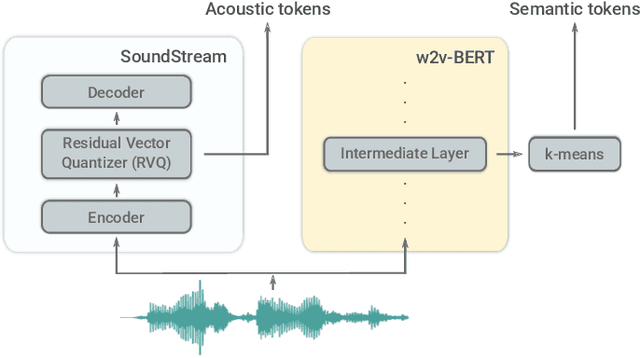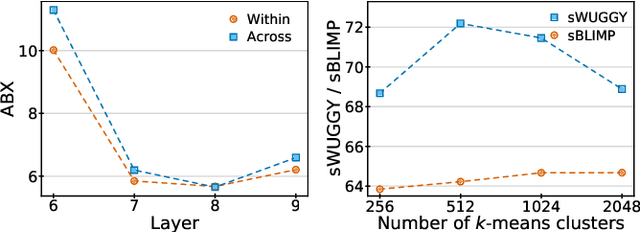Zalán Borsos
MusicRL: Aligning Music Generation to Human Preferences
Feb 06, 2024Abstract:We propose MusicRL, the first music generation system finetuned from human feedback. Appreciation of text-to-music models is particularly subjective since the concept of musicality as well as the specific intention behind a caption are user-dependent (e.g. a caption such as "upbeat work-out music" can map to a retro guitar solo or a techno pop beat). Not only this makes supervised training of such models challenging, but it also calls for integrating continuous human feedback in their post-deployment finetuning. MusicRL is a pretrained autoregressive MusicLM (Agostinelli et al., 2023) model of discrete audio tokens finetuned with reinforcement learning to maximise sequence-level rewards. We design reward functions related specifically to text-adherence and audio quality with the help from selected raters, and use those to finetune MusicLM into MusicRL-R. We deploy MusicLM to users and collect a substantial dataset comprising 300,000 pairwise preferences. Using Reinforcement Learning from Human Feedback (RLHF), we train MusicRL-U, the first text-to-music model that incorporates human feedback at scale. Human evaluations show that both MusicRL-R and MusicRL-U are preferred to the baseline. Ultimately, MusicRL-RU combines the two approaches and results in the best model according to human raters. Ablation studies shed light on the musical attributes influencing human preferences, indicating that text adherence and quality only account for a part of it. This underscores the prevalence of subjectivity in musical appreciation and calls for further involvement of human listeners in the finetuning of music generation models.
TokenSplit: Using Discrete Speech Representations for Direct, Refined, and Transcript-Conditioned Speech Separation and Recognition
Aug 21, 2023


Abstract:We present TokenSplit, a speech separation model that acts on discrete token sequences. The model is trained on multiple tasks simultaneously: separate and transcribe each speech source, and generate speech from text. The model operates on transcripts and audio token sequences and achieves multiple tasks through masking of inputs. The model is a sequence-to-sequence encoder-decoder model that uses the Transformer architecture. We also present a "refinement" version of the model that predicts enhanced audio tokens from the audio tokens of speech separated by a conventional separation model. Using both objective metrics and subjective MUSHRA listening tests, we show that our model achieves excellent performance in terms of separation, both with or without transcript conditioning. We also measure the automatic speech recognition (ASR) performance and provide audio samples of speech synthesis to demonstrate the additional utility of our model.
AudioPaLM: A Large Language Model That Can Speak and Listen
Jun 22, 2023



Abstract:We introduce AudioPaLM, a large language model for speech understanding and generation. AudioPaLM fuses text-based and speech-based language models, PaLM-2 [Anil et al., 2023] and AudioLM [Borsos et al., 2022], into a unified multimodal architecture that can process and generate text and speech with applications including speech recognition and speech-to-speech translation. AudioPaLM inherits the capability to preserve paralinguistic information such as speaker identity and intonation from AudioLM and the linguistic knowledge present only in text large language models such as PaLM-2. We demonstrate that initializing AudioPaLM with the weights of a text-only large language model improves speech processing, successfully leveraging the larger quantity of text training data used in pretraining to assist with the speech tasks. The resulting model significantly outperforms existing systems for speech translation tasks and has the ability to perform zero-shot speech-to-text translation for many languages for which input/target language combinations were not seen in training. AudioPaLM also demonstrates features of audio language models, such as transferring a voice across languages based on a short spoken prompt. We release examples of our method at https://google-research.github.io/seanet/audiopalm/examples
SoundStorm: Efficient Parallel Audio Generation
May 16, 2023Abstract:We present SoundStorm, a model for efficient, non-autoregressive audio generation. SoundStorm receives as input the semantic tokens of AudioLM, and relies on bidirectional attention and confidence-based parallel decoding to generate the tokens of a neural audio codec. Compared to the autoregressive generation approach of AudioLM, our model produces audio of the same quality and with higher consistency in voice and acoustic conditions, while being two orders of magnitude faster. SoundStorm generates 30 seconds of audio in 0.5 seconds on a TPU-v4. We demonstrate the ability of our model to scale audio generation to longer sequences by synthesizing high-quality, natural dialogue segments, given a transcript annotated with speaker turns and a short prompt with the speakers' voices.
LMCodec: A Low Bitrate Speech Codec With Causal Transformer Models
Mar 23, 2023Abstract:We introduce LMCodec, a causal neural speech codec that provides high quality audio at very low bitrates. The backbone of the system is a causal convolutional codec that encodes audio into a hierarchy of coarse-to-fine tokens using residual vector quantization. LMCodec trains a Transformer language model to predict the fine tokens from the coarse ones in a generative fashion, allowing for the transmission of fewer codes. A second Transformer predicts the uncertainty of the next codes given the past transmitted codes, and is used to perform conditional entropy coding. A MUSHRA subjective test was conducted and shows that the quality is comparable to reference codecs at higher bitrates. Example audio is available at https://mjenrungrot.github.io/chrome-media-audio-papers/publications/lmcodec.
Speak, Read and Prompt: High-Fidelity Text-to-Speech with Minimal Supervision
Feb 07, 2023Abstract:We introduce SPEAR-TTS, a multi-speaker text-to-speech (TTS) system that can be trained with minimal supervision. By combining two types of discrete speech representations, we cast TTS as a composition of two sequence-to-sequence tasks: from text to high-level semantic tokens (akin to "reading") and from semantic tokens to low-level acoustic tokens ("speaking"). Decoupling these two tasks enables training of the "speaking" module using abundant audio-only data, and unlocks the highly efficient combination of pretraining and backtranslation to reduce the need for parallel data when training the "reading" component. To control the speaker identity, we adopt example prompting, which allows SPEAR-TTS to generalize to unseen speakers using only a short sample of 3 seconds, without any explicit speaker representation or speaker-id labels. Our experiments demonstrate that SPEAR-TTS achieves a character error rate that is competitive with state-of-the-art methods using only 15 minutes of parallel data, while matching ground-truth speech in terms of naturalness and acoustic quality, as measured in subjective tests.
MusicLM: Generating Music From Text
Jan 26, 2023



Abstract:We introduce MusicLM, a model generating high-fidelity music from text descriptions such as "a calming violin melody backed by a distorted guitar riff". MusicLM casts the process of conditional music generation as a hierarchical sequence-to-sequence modeling task, and it generates music at 24 kHz that remains consistent over several minutes. Our experiments show that MusicLM outperforms previous systems both in audio quality and adherence to the text description. Moreover, we demonstrate that MusicLM can be conditioned on both text and a melody in that it can transform whistled and hummed melodies according to the style described in a text caption. To support future research, we publicly release MusicCaps, a dataset composed of 5.5k music-text pairs, with rich text descriptions provided by human experts.
AudioLM: a Language Modeling Approach to Audio Generation
Sep 07, 2022



Abstract:We introduce AudioLM, a framework for high-quality audio generation with long-term consistency. AudioLM maps the input audio to a sequence of discrete tokens and casts audio generation as a language modeling task in this representation space. We show how existing audio tokenizers provide different trade-offs between reconstruction quality and long-term structure, and we propose a hybrid tokenization scheme to achieve both objectives. Namely, we leverage the discretized activations of a masked language model pre-trained on audio to capture long-term structure and the discrete codes produced by a neural audio codec to achieve high-quality synthesis. By training on large corpora of raw audio waveforms, AudioLM learns to generate natural and coherent continuations given short prompts. When trained on speech, and without any transcript or annotation, AudioLM generates syntactically and semantically plausible speech continuations while also maintaining speaker identity and prosody for unseen speakers. Furthermore, we demonstrate how our approach extends beyond speech by generating coherent piano music continuations, despite being trained without any symbolic representation of music.
Disentangling speech from surroundings in a neural audio codec
Mar 29, 2022


Abstract:We present a method to separate speech signals from noisy environments in the compressed domain of a neural audio codec. We introduce a new training procedure that allows our model to produce structured encodings of audio waveforms given by embedding vectors, where one part of the embedding vector represents the speech signal, and the rest represents the environment. We achieve this by partitioning the embeddings of different input waveforms and training the model to faithfully reconstruct audio from mixed partitions, thereby ensuring each partition encodes a separate audio attribute. As use cases, we demonstrate the separation of speech from background noise or from reverberation characteristics. Our method also allows for targeted adjustments of the audio output characteristics.
SpeechPainter: Text-conditioned Speech Inpainting
Feb 15, 2022


Abstract:We propose SpeechPainter, a model for filling in gaps of up to one second in speech samples by leveraging an auxiliary textual input. We demonstrate that the model performs speech inpainting with the appropriate content, while maintaining speaker identity, prosody and recording environment conditions, and generalizing to unseen speakers. Our approach significantly outperforms baselines constructed using adaptive TTS, as judged by human raters in side-by-side preference and MOS tests.
 Add to Chrome
Add to Chrome Add to Firefox
Add to Firefox Add to Edge
Add to Edge